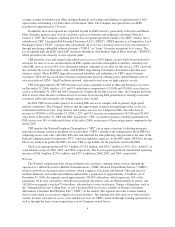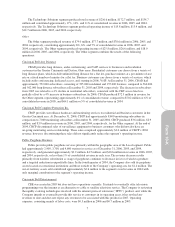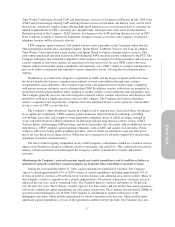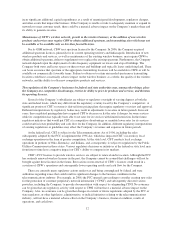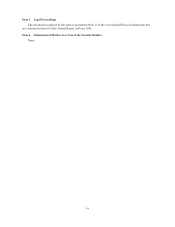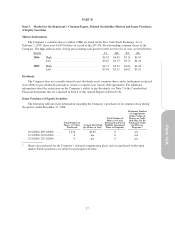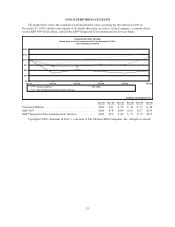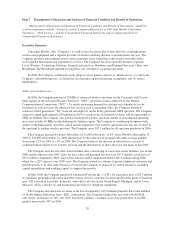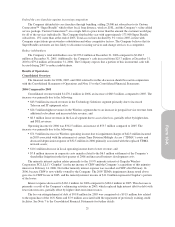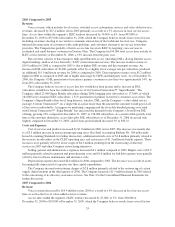Cincinnati Bell 2006 Annual Report Download - page 124
Download and view the complete annual report
Please find page 124 of the 2006 Cincinnati Bell annual report below. You can navigate through the pages in the report by either clicking on the pages listed below, or by using the keyword search tool below to find specific information within the annual report.violations of such laws, the imposition of cleanup obligations, and third-party suits. For instance, a number of the
Company’s sites formerly contained underground storage tanks for the storage of used oil and fuel for back-up
generators and vehicles. In addition, a few sites currently contain underground tanks for back-up generators, and
many of the Company’s sites have aboveground tanks for similar purposes.
The Company generates a substantial portion of its revenue by serving a limited geographic area.
The Company generates a substantial portion of its revenue by serving customers in the Greater Cincinnati
and Dayton, Ohio areas. An economic downturn or natural disaster occurring in this limited operating territory
could have a disproportionate effect on the Company’s business, financial condition, results of operations, and
cash flows compared to similar companies of a national scope and similar companies operating in different
geographic areas.
Third parties may claim that the Company is infringing upon their intellectual property, and the Company
could suffer significant litigation or licensing expenses or be prevented from selling products.
Although the Company does not believe that any of its products or services infringes upon the valid
intellectual property rights of third parties, the Company may be unaware of intellectual property rights of others
that may cover some of its technology, products or services. Any litigation growing out of third-party patents or
other intellectual property claims could be costly and time-consuming and could divert the Company’s
management and key personnel from the business operations. The complexity of the technology involved and the
uncertainty of intellectual property litigation increase these risks. Resolution of claims of intellectual property
infringement might also require the Company to enter into costly license agreements. Likewise, the Company
may not be able to obtain license agreements on acceptable terms. The Company also may be subject to
significant damages or injunctions against development and sale of certain of its products. Further, the Company
often relies on licenses of third-party intellectual property useful for its businesses. The Company cannot ensure
that these licenses will be available in the future on favorable terms or at all.
Third parties may infringe the Company’s intellectual property, and the Company may expend significant
resources enforcing its rights or suffer competitive injury.
The Company’s success depends in significant part on the competitive advantage it gains from its
proprietary technology and other valuable intellectual property assets. The Company relies on a combination of
patents, copyrights, trademarks and trade secrets protections, confidentiality provisions and licensing
arrangements to establish and protect its intellectual property rights. If the Company fails to successfully enforce
its intellectual property rights, its competitive position could suffer, which could harm its operating results.
The Company’s pending patent and trademark registration applications may not be allowed, or competitors
may challenge the validity or scope of its patents, copyrights or trademarks. Further, the Company may be
required to spend significant resources to monitor and police its intellectual property rights. The Company may
not be able to detect third-party infringements and its competitive position may be harmed before the Company
does so. In addition, competitors may design around the Company’s technology or develop competing
technologies. Furthermore, some intellectual property rights are licensed to other companies, allowing them to
compete with the Company using that intellectual property.
Uncertainty in the U.S. securities markets and adverse medical cost trends could cause the Company’s pension
and postretirement costs to increase.
The Company’s pension and postretirement costs have increased in recent years, primarily due to a
continued increase in medical and prescription drug costs. Investment returns of the Company’s pension funds
depend largely on trends in the U.S. securities markets and the U.S. economy in general. In particular,
uncertainty in the U.S. securities markets and U.S. economy could result in investment returns less than those
previously assumed and a decline in the value of plan assets used in pension and postretirement calculations.
Should the securities markets decline and medical and prescription drug costs continue to increase significantly,
the Company would expect to face increasing annual combined net pension and postretirement costs. Refer to
Note 9 to the Consolidated Financial Statements.
14


